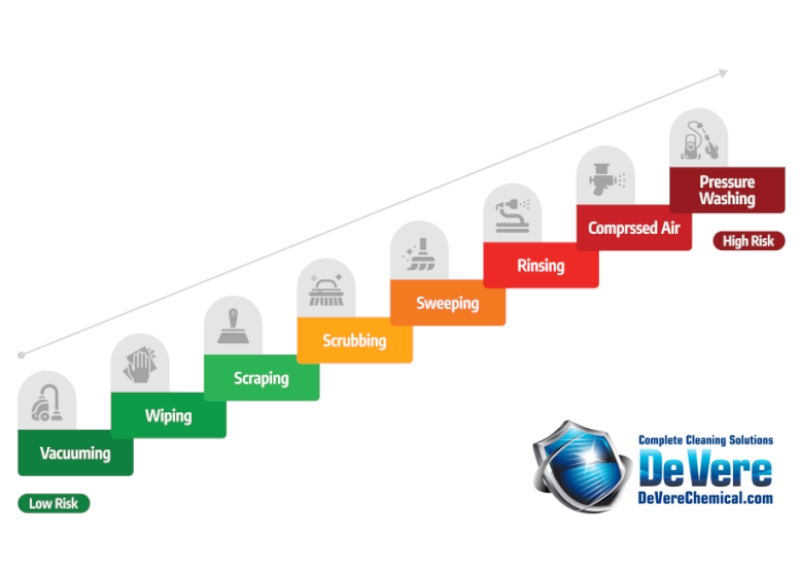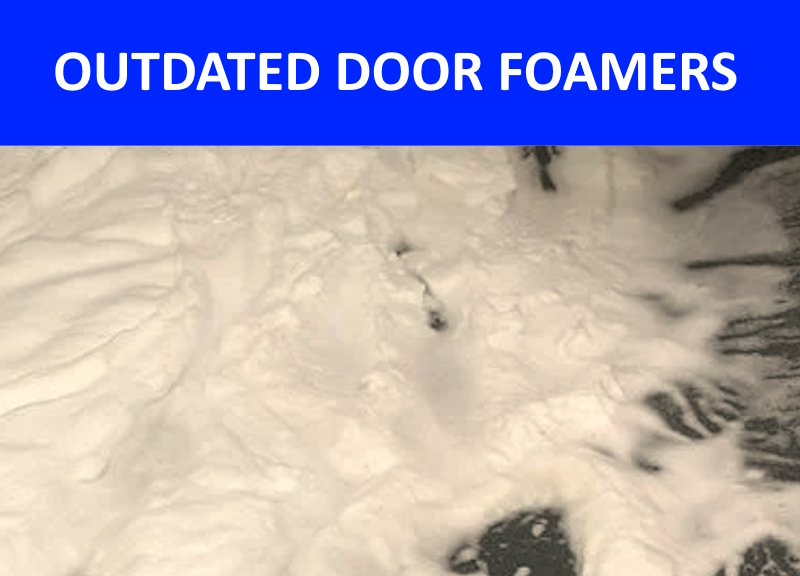
Wet sanitation involves using water or liquid-based cleaning agents to clean surfaces, objects, or equipment. Wet sanitation is commonly used in food preparation areas, healthcare facilities, and other environments where strict hygiene standards are required. It is effective in removing visible dirt and reducing microbial contamination. It also leads to a lot of water waste. Dry sanitation involves cleaning and disinfecting surfaces without using water or liquid-based solutions. Dry sanitation is often used when water or liquid-based cleaning agents are impractical or undesirable, such as electrical equipment, sensitive machinery, or surfaces that may be damaged by excessive moisture.
Nathan Mirdamadi, Senior Food Safety Specialist with Commercial Food Sanitation, said, “Water poses a significant food safety risk in dry and low moisture food processing environments.” ¹ Considering the harmful effects of microorganism growth on human health, this makes cleaning and sanitizing these areas challenging.
But what about the microbial spread risk encouraged by the products intended to mitigate them? Effective cleaning and sanitizing in dry environments are a significant concern, particularly considering that most cleaning and sanitizing products today are composed primarily of water.
Whether cleaning food contact surfaces or flooring, in wet and dry environments, pathogens hide in plain sight, in cracks and crevices that are difficult to see, clean, and inspect. Wetness can encourage their attachment to surfaces and microbial growth. The problem is further compounded in the dry food processing environment as the dry material mixes with moisture to form a paste.
Dry Sanitation
In the U.S., dry sanitization of food-contact surfaces requires an EPA-registered food-contact surface sanitizer. However, this should not introduce unnecessary moisture. If the sanitizer is approved, no rinse is needed. DeVere’s QDII Sanitizer meets this criterion.
According to Joe Stout, RS, author and founder of Commercial Food Sanitation, “There is a “war on water” in the baking industry. It focuses heavily on reducing or stopping the use of water in dry facilities unless absolutely necessary. The use or presence of water — or even moisture — is a significant risk factor for contamination. If present, water allows pathogen growth and is an excellent and efficient way to spread pathogens throughout a facility. A major concern is the transfer of pathogens through puddles, roof leaks, condensation and aerosols from the use of water hoses that may be carried to dry areas by air currents and other means.” ²
Before cleaning, understand the purpose and goal, then design your plan accordingly. Suppose you are cleaning for microbiological reasons, chemical reasons such as allergens, or cleaning to control foreign material or buildup of product that resembles foreign material in the finished product. In that case, you must meet the sanitary goal. Often, you could be trying to accomplish all these things. However, the main objective needs to follow the criteria for success, and once defined, a Sanitation Standard Operating Procedure (SSOP) can be created to meet, validate, and verify it. DeVere’s Degrease Powder works on fats, oils, and grease to quickly emulsify spills so they can easily be scraped or brushed away without needing water.
Understanding when to use wet sanitation or dry sanitation is critical as you look to meet sanitation goals.
Treat Water Like Glass ³
Water should be included as a “physical hazard” in the Hazard Analysis of a Hazard Analysis and Critical Control Points plan and a food safety plan.
- Treat uncontrolled water in the plant like you would your own home; take care of it right away
- Uncontrolled water, if left untreated, can cause extensive damage and be expensive to repair
- When not fixed immediately, uncontrolled water creates an environment that is perfect for microbial growth and damage to the structure and equipment, along with increased pest activity
WOW – War on Water
There are many reasons why developing an uncontrolled-water plan is so vital to a food production facility. For one, a plan is crucial in making a step change in pathogen risk reduction and spoilage organism control.
- Uncontrolled water leads to significant microbial growth in food products such as Listeria, Salmonella, yeast, and mold
- Uncontrolled water also leads to human safety hazards such as chemical and slip hazards
- Water also poses a risk to production equipment, impacting its reliability and functionality
- Uncontrolled water also hurts a company’s environmental and sustainability goals
- Water also contributes to contamination risk within all areas of a plant by moving other contaminants around
For unparalleled control over microbial contamination in food products, such as Listeria and Salmonella, try DeVere’s patented products, Security Floor Sanitizer, which is EPA-registered, or Security Floor Treatment.
Cleaning Methods That Minimize Water Risk

Figure 1 aligns the cleaning methods applied with the development of uncontrolled-water plans. It shows the levels of risk, from the lowest-risk cleaning activities, such as vacuuming and wiping, to the highest-risk, like high-pressure water and the use of compressed air. The objective is to use controlled methods to collect the soil or material we are cleaning up rather than dispersing it into other areas around the facility.
The goal is to minimize the impact, time, and frequency of cleaning that water has on the environment.
Toward More Efficient Changeovers
If there is no food safety crisis or event, the driving factor needs to focus on the positive financial impact of implementing an uncontrolled-water plan. Ultimately, food safety is the driver, but using the monetary impact as the force to build the business case for a dry cleaning initiative will gain acceptance and support.
- Minimize disruption caused by changing the cleaning method by focusing on the goal
- Minimize time for cleaning by following quick changeover (QCO) principles
- Minimize the frequency of cleaning
- Conduct a comprehensive assessment on the reasons to clean (beyond food safety and quality, think operational needs and plant safety needs)
DeVere’s Triple Dry is an excellent choice for cleaning lines quickly without the hassle of long downtimes.
Order Cleaning Methods by Preference
Give guidance to business team members about the order of preference for cleaning methods. When thinking about value-stream mapping, the ideal state is a no-cleaning scenario. While not cleaning may seem unreasonable, there are a few limited times when a no-cleaning procedure can be applied. The order of preference for cleaning methods to be considered from a financial cost and low-to-high microbial risk is no cleaning needed, purge, dry clean, dry clean with chemicals, clean in place (CIP), controlled wet cleaning, assisted cleaning system (ACS), controlled CIP, and flood cleaning.
Key Takeaways
- Controlling the risks and financial costs of cleaning can be done by developing and implementing the correct cleaning methods
- Developing an internal water-control program, like an audit program for glass and brittle plastic, is required to design out that hazard
- The goal is to eliminate the unnecessary use of water within a production facility
- Starts with choosing the right type of equipment
“In dry processing plants, dry cleaning, and sanitizing practices are a necessity, but the process can be just as beneficial for many areas of wet processing plants as well. While introducing water into a low-moisture production area can adulterate the product, cause mold, and affect product shelf life, reducing water in other environments also can increase food safety.” ⁴
In the Zone
Dry cleaning is used primarily in zones 1 to 3 (food contact surfaces to areas outside the areas around food contact surfaces).
Seven steps in the dry cleaning process:
1. Sanitation preparation
a. Purge all systems
b. Assemble cleaning equipment
2. Secure and disassemble equipment
a. Lock out/tag out (LOTO)
b. Remove guards, release belt tension from conveyors, remove parts, disassemble all components
3. Dry clean
a. Scrape, brush down, vacuum, dry ice cleaning, dry steam cleaning
b. Use a systemic approach of top-down cleaning
c. Sweep, remove, empty and clean trash
4. Detail cleaning
a. Hand scrape any surfaces with residual product
b. Wipe down equipment as necessary
c. Clean framework
d. Identify and spot clean problem areas
5. Post inspection and re-clean
a. LOTO, inspect for visually clean
6. Pre-operational inspection
a. Correct any deficiencies, reassemble equipment, remove LOTO
7. Sanitize and release
a. Document corrective actions, release for production
Dry Cleaning Benefits
- Reduce moisture in the plant
- Reduce cleaning and sanitation downtime of plant
- Environmental benefits: less cleaning product use and waste, reduced labor
- Can be used on electrical components and electronic equipment that cannot withstand water
- Maintenance personnel can use this method to clean and sanitize tools to protect them from water-based cleaners that can cause corrosion; also a quicker way to sanitize tools without having to wait through the water-based cleaner dry time
Dry cleaning is sometimes used in wet processing plants on a rotational basis. By periodically rotating sanitizers, they avoid resistant strains of bacteria developing in the plant. How this is achieved would be to use a quaternary compound, switch to a peracetic acid, use an alcohol-based sanitizer, and then begin again with the quaternary compound.
Please Contact Us or call 1-800-833-8373 with questions about purchasing QDII Sanitizer, Degrease Powder, Security Floor Sanitizer, Security Floor Treatment, Triple Dry or if you would like help with any cleaning or sanitizing products or applications.
References
- Contributor, G. (2022, November). foodsafetynews.com. Retrieved from FSN | Food Safety News: https://www.foodsafetynews.com/2022/11/when-water-is-the-enemy-sanitizing-in-dry-food-processing-environments/
- Stout, J. (2017, April 10). CFS. Retrieved from commercialfoodsanitation.com: https://www.commercialfoodsanitation.com/news/wet-vs-dry-cleaning-part-one
- Lupo, L. (2013, December). Quality Assurance & Food Safety. Retrieved from qualityassurancemag.com: https://www.qualityassurancemag.com/article/qa1213-dry-cleaning-reducing-moisture/
- Karl Thorson, G. R. (2019, April 16). FoodSafety Magazine. Retrieved from food-safety.com: https://www.food-safety.com/articles/6178-reduced-moisture-design-sanitation-best-practices





0 Comment